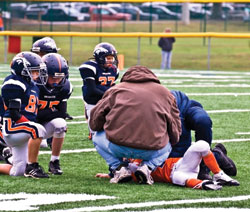
 |
| A player on the ground being checked by his coach during a regular season game in Forsyth County, Cumming Georgia. © Susan Leggett - Dreamstime.com |
The sporting world encompasses a wide variety of events; beyond the different types of sports played, individuals or teams may be amateur or professional, youth, collegiate or adult, competing in a small local tournament or large nationally sanctioned events. Preparing for any sports event comes with a long to-do list and purchasing insurance can sometimes fall off the radar. However, signing up for coverage requires careful consideration and should never be a last-minute decision. Choosing a reliable insurance provider, deciding on the types and limits of coverage needed and completing the insurance applications are all steps in a process that will ultimately protect your organization should an incident occur.
There are many types of coverage needed for various entities involved in sports events. For example, teams and leagues should purchase insurance designed to protect the organization, including its employees and volunteers. An organization hosting a tournament should purchase coverage for the event, which is often required by the facility where the event takes place. And facilities hosting events need their own insurance coverage as well.
What kind of insurance should I buy?
Commercial general liability insurance, often referred to simply as liability coverage, protects the insured against liability lawsuits or claims, from a third party, for bodily injury and property damage arising out of the insured's premises and operations, and for personal and advertising injury. Defending your organization against and paying for a liability claim is expensive. Liability insurance not only pays for damages you are held legally liable for, but should also cover the cost of investigation and defense of claims, even if they are groundless. Always ask your insurance provider if defense costs are outside of your limits of coverage; if they are included, legal costs may quickly burn through your coverage limits.
 |
| Rider during an accident on Alpes Cup, mountain bike competition. © Andres Morales - Dreamstime.com |
Sports organizations should look for CGL coverage designed specifically for their needs. For example, if the younger brother of a player wanders onto the field before the game, climbs onto the soccer net, falls and is injured, liability insurance will respond. Or perhaps the grandmother of a participant trips over the team's sports equipment, breaking her leg, and demands that the team pay for medical attention. Again, liability insurance will protect the organization.
Legal liability to participants may also be a part of package insurance offered to sports organizations. This coverage protects the insured organization against bodily injury claims brought by persons participating in covered sports activities. Professional liability provides protection for claims arising out of the rendering or failure to render instruction, demonstration, direction or advice relating to the sports activity.
Medical payments for participants coverage pays medical and dental expenses incurred by a participant when accidental injury occurs while participating in covered sports activities (this coverage is usually on an excess basis, after all other medical coverage available to the participant has been exhausted).
In addition to liability coverage, sports organizations want to consider inland marine coverage, sometimes called equipment and contents coverage. This provides coverage for direct loss or damage to sports equipment, field maintenance equipment, concession stand equipment and portable storage sheds.
Sports organizations may also be able to purchase other optional coverages such as hosted tournament coverage or directors' and officers' liability coverage. Depending on the size and activities of the organization, additional liability coverage and other insurance products such as property, commercial auto, crime and excess liability may be needed. Working with a licensed insurance professional is always the best option when making decisions regarding complex insurance coverages. An experienced provider will understand how various types of insurance interact to provide adequate coverage.
 |
| A young player down after a tackle on the field during a little league football game. © Susan Leggett - Dreamstime.com |
What does it mean to have an additional insured added to my policy? An additional insured is an entity which has an insurable interest for claims arising out of your negligence as the named insured. A certificate of insurance is provided to the additional insured providing proof of coverage. If you are an event organizer, the venue or facility may require you to show proof of liability and list them as an additional insured to your policy. This will protect you, the named insured, and the venue/facility for defense and indemnity costs (if policy limits have not been exhausted) brought by a third party (spectators) or by participating teams.
This is a very common request and, unfortunately, can sometimes be a source of added costs from insurance providers who charge an extra fee for certificates of insurance, sometimes as much as $25 to $50 for each certificate requested. This is an important financial consideration for sports organizations when choosing an insurance provider.
How much should I buy? The policy "limit" is the dollar amount of protection purchased and will receive when there is a claim. For example, you may choose to buy a policy that offers a $2,000,000 occurrence limit with a $4,000,000 aggregate limit. This means that your limit for an individual incident is $2M with a total limit of $4M for all incidents occurring while the policy is in effect. Facilities or tournament hosts may mandate minimum limits, which can vary. Before purchasing coverage, be sure to check any contract or agreement you sign for insurance requirements.
What should I look for in an insurance provider? When choosing an insurance provider, always ask about the financial stability of the carrier; a high rating (A or better) by an independent rating company such as A.M. Best Company is the safest choice. Also, choosing a carrier that is "admitted" (licensed) is preferable because choosing an insurance company that is non-admitted (called surplus lines) may require you to pay extra fees or taxes.
Of course, experience is also a factor. Companies familiar with the unique risks associated with sports organizations and events will be able to accurately price coverage and more importantly, provide prompt and reliable claims handling services. You may also want to look for convenient services such as the ability to apply and purchase coverage online, as opposed to completing a paper application that must be mailed and approved before coverage is in force.
Purchasing the right type and amount of insurance will ultimately give you peace of mind when preparing for your next event. Choose the right liability coverage for your sports organization and you'll be able to focus on other details, knowing that you've got the coverage you need.

